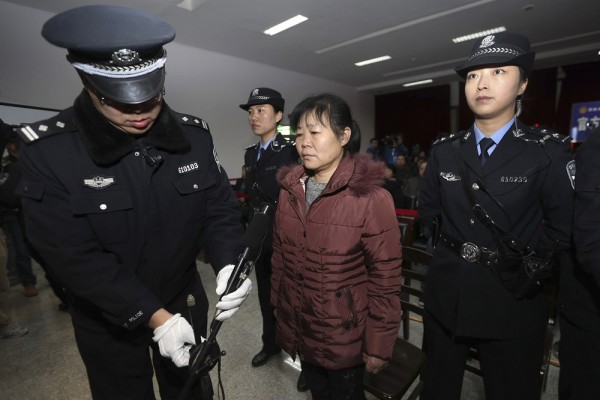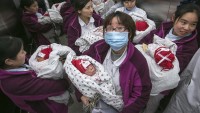Police Rescue Babies Sold To Traffickers
| Vittorio Hernandez | | Apr 25, 2015 09:20 AM EDT |
(Photo : Reuters) Zhang Shuxia, an obstetrician involved in baby trafficking, stands trial in Weinan Intermediate People's Court in Weinan, Shaanxi province, December 30, 2013. Zhang was accused of selling babies after cheating parents that their newborn babies had infectious diseases or congenital malformation, according to local media. REUTERS/China Daily (CHINA - Tags: CRIME LAW HEALTH)
To evade detection by authorities, baby trafficking gangs bring expectant mothers to where the buyers live rather than travel with an infant, which could arouse suspicion amid ongoing crackdown on baby-trafficking gangs.
The expectant mothers are made to stay in pig farms where they give birth. In the process, the mothers' health are neglected. Compounding this is that most of Chinese women selling their babies are drug addicts, which results in many babies sold having birth defects.
Like Us on Facebook
One such baby is Mingming, a boy, who was sold for 70,000 yuan or $11,300. However, three months after his birth, Mingming was diagnosed with cerebral palsy, reports China.org.
Mingming is one of the 64 babies rescued by cops in six Chinese provinces this week. The operations led to the arrest of 171 suspects, reports Beijing Times.
Female babies sold for 50,000 yuan. After the birth of the babies, the gang buys a birth certificate at 4,000 yuan.
The baby trade is flourishing in China despite the country already bursting to the seams with a population of 1.3 billion people. It is because of the one-child policy which has resulted in higher preference for male children and abortion or lesser preference for female infants.
In 2013, police rescued 52,000 children kidnapped by child-trafficking groups.
In January, 37 babies and a three-year-old girl was rescued in Shandong province. Most of the rescued were suffering from various ailments such as AIDS/HIV and were malnourished, according to CNN. The selling price ranged from 50,000 to 80,000 yuan or from $8,000 to $12,000.
The malnutrition was because most of the time, the babies for sale were only given instant noodles or leftover vegetables.
In the January operations, authorities arrested 103 people who either trafficked or bought the babies. The gang was busted after police noticed a group of pregnant women entering an abandoned factory in Jining. When the plant was raided, the police found nappies and other evidence that it was used as a hidden delivery room. After the babies were born, they were transported in large handbags and suitcases during the delivery to the buyers to avoid detection.
Tagsbaby trafficking
©2015 Chinatopix All rights reserved. Do not reproduce without permission
EDITOR'S PICKS
-

Did the Trump administration just announce plans for a trade war with ‘hostile’ China and Russia?
-

US Senate passes Taiwan travel bill slammed by China
-

As Yan Sihong’s family grieves, here are other Chinese students who went missing abroad. Some have never been found
-

Beijing blasts Western critics who ‘smear China’ with the term sharp power
-

China Envoy Seeks to Defuse Tensions With U.S. as a Trade War Brews
-

Singapore's Deputy PM Provides Bitcoin Vote of Confidence Amid China's Blanket Bans
-

China warns investors over risks in overseas virtual currency trading
-

Chinese government most trustworthy: survey
-

Kashima Antlers On Course For Back-To-Back Titles
MOST POPULAR
LATEST NEWS
Zhou Yongkang: China's Former Security Chief Sentenced to Life in Prison

China's former Chief of the Ministry of Public Security, Zhou Yongkang, has been given a life sentence after he was found guilty of abusing his office, bribery and deliberately ... Full Article
TRENDING STORY

China Pork Prices Expected to Stabilize As The Supplies Recover

Elephone P9000 Smartphone is now on Sale on Amazon India

There's a Big Chance Cliffhangers Won't Still Be Resolved When Grey's Anatomy Season 13 Returns

Supreme Court Ruled on Samsung vs Apple Dispute for Patent Infringement

Microsoft Surface Pro 5 Rumors and Release Date: What is the Latest?












